Oral
Body: Breast, Chest, Abdomen, Pelvis
Wednesday, 26 April 2017
| Room 314 |
16:15 - 18:15 |
Moderators: Christiane Kuhl, Elizabeth Morris |
Slack Channel: #s_body
Session Number: O30
16:15
|
0942.
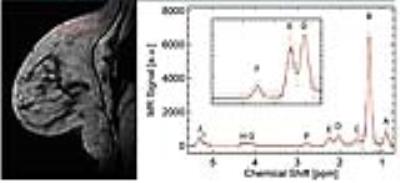 |
Saturated fatty acid fraction in breast adipose tissue is higher in patients with cancer than in those with benign lesions 
Sungheon Gene Kim, Neeti Bagadiya, Pippa Storey, Melanie Moccaldi, Linda Moy
Gradient-echo Spectroscopic Imaging (GSI) was used to conduct voxel-wise analysis of fatty acid composition in breast adipose tissue in postmenopausal women. Parametric maps of fatty acid fractions show significantly higher saturated fatty acids in women with malignant tumors than in those with benign lesions. This result is consistent with a previous study based on manually selected regions of interest, and suggests that, for post-menopausal women, higher saturated fatty acids may be related to breast cancer development. Non-invasive evaluation of lipid composition using GSI may aid in breast cancer risk assessment and provide insight into physiological mechanisms that facilitate cancer development.
|
16:27
|
0943.
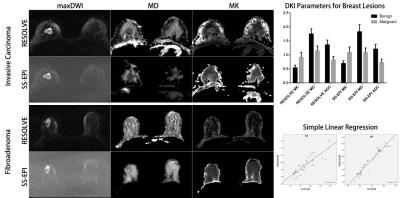 |
Diffusion Kurtosis Imaging with Readout-Segmented SE-EPI for Breast Lesions: Comparison with Single-shot SE-EPI at 3T 
TAO AI, Ya-guang Li, Li-ming Xia
As an effective and sensitive diagnostic modality for tumor imaging, routine DWI and DKI based SS-EPI are limited by image distortion and poor spatial resolution at 3T, which can be significantly improved by RESOLVE technique.
|
16:39
|
0944.
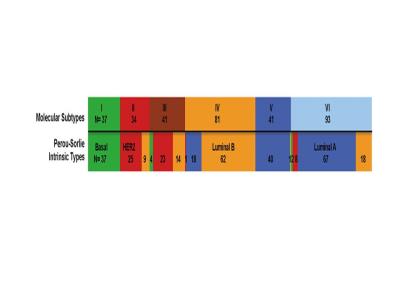 |
Correlation between Breast Cancer Molecular Subtypes and Parameters of Dynamic Contrast Enhanced (DCE) MRI and Intravoxal Incoherent Motion (IVIM): Implication for Breast Cancer Anti-angiogenesis Treatment Guidance 
WanChen Tsai, KaiMing Chang, KuoJang Kao
This prospective study correlates DCE MRI and IVIM with breast cancer molecular subtypes by examine the differences in vascular normalization signature genes. We found molecular subtype III and VI with higher pericyte gene scores to have significantly lower perfusion related parameters, higher extracellular extra-vascular space on DCE MRI and IVIM. These associations may be used to guide anti-angiogenesis treatment for breast cancer.
|
16:51
|
0945.
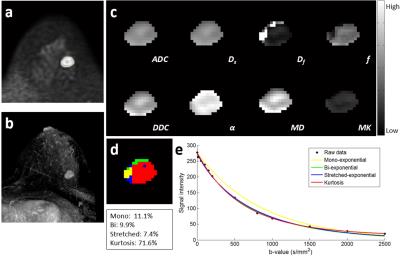 |
Multi-parametric Diffusion-weighted Imaging Models: Useful Tools for Diagnosis and Prognosis in Breast Cancer? - permission withheld
Shiteng Suo, Fang Cheng, Jia Hua, Qing Lu, Lyu Li, Jianrong Xu
Multi-parametric diffusion-weighted imaging (DWI) has shown potential in characterizing breast cancer. In this study, we for the first time evaluated the four common diffusion models in various breast lesions. Results showed that (1) optimal DWI signal attenuation behaviors differ between benign and malignant breast lesions (kurtosis model suited for benign and stretched-exponential model suited for malignant); (2) for predicting the malignancy of breast lesions, or the invasive nature of breast cancer, mono-exponential ADC is still the most preferred parameter; and (3) parameters based on non-mono-exponential DWI models may be more related with prognostic factors in invasive breast cancer.
|
17:03
|
0946.
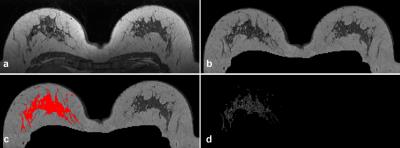 |
Complementary value of contralateral parenchymal enhancement on DCE-MRI to conventional prognostic models and molecular assays of breast cancer - permission withheld
Bas van der Velden, Tycho Bismeijer, Claudette Loo, Lodewyk Wessels, Max Viergever, Kenneth Gilhuijs
The purpose of this study was to assess whether MR contrast-enhancement in healthy stromal tissue of the breast is able to further stratify survival of patients considered to be at high risk according to prognostic models derived from the tumor. In 415 patients with pathology proven unilateral invasive ER+HER2- breast cancer, the contralateral parenchymal enhancement was automatically extracted. Contralateral parenchymal enhancement appears to complement existing prognostic models derived from the tumor. In patients at high risk according to conventional prognostic models or molecular assays, contralateral parenchymal enhancement was able identify a subgroup with a relative good survival.
|
17:15
|
0947.
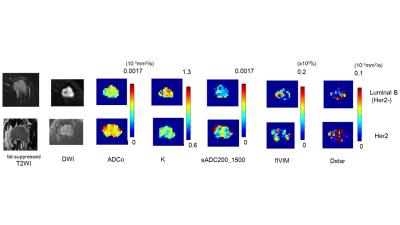 |
Quantitative non-Gaussian diffusion and IVIM MRI: Correlation between synthetic parameters and breast cancer biomarkers 
Mami Iima, Masako Kataoka, Shotaro Kanao, Natsuko Onishi, Makiko Kawai, Akane Ohashi, Rena Sakaguchi, Ayami Ohno Kishimoto, Masakazu Toi, Kaori Togashi
The association of IVIM/non-Gaussian diffusion MRI parameters with biological feature or subtypes in breast cancer was evaluated. For 144 malignant lesions, IVIM (fIVIM,D*) and non-Gaussian diffusion (ADCo,K)
parameters were estimated from DWI series with 16 b values (0-2500sec/mm2), as well as syntheticADC (sADC) (b=200,1500sec/mm2) and ADC (b=0,800sec/mm2). sADC and
K values were significantly different between ER,PgR,andHer2 status (p<0.05,0.01,0.05 for sADC and p<0.05,0.05,0.05 for K). There was a significant difference of ADC values between PgRandHer2 status (p<0.05,0.01). No significant difference of IVIM was found. ADCo, sADC,
and ADC showed the statistical significance in differentiating subtypesof breast cancer (p<0.05,<0.01,<0.01).
|
17:27
|
0948.
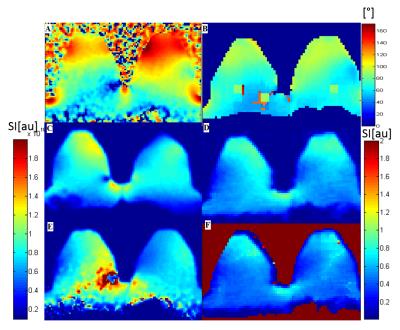 |
B1 Mapping for Breast Sodium MRI at 7T- A Comparison between Double Angle and Phase-sensitive Method 
Olgica Zaric, Lenka Minarikova, Sefan Zbyn, Armin Nagel, Lena Gast, Siegfrid Trattnig
Absolute values of sodium content in tumors is one of the most important biomarkers for cancer diagnostics and therapy monitoring. An accurate quantitative values are influenced by B1 inhomogeneity that must be evaluated and corrected. In this work, we compared two mapping methods DAM and PS. On the basis of our results, we found that DAM gives overestimated flip angle values (approximately 30% higher than PS). Also, after correction is applied, DAM shows higher signal drop in comparison with PS. Accompanied with longer measurement time necessary for DAM, this findings give advantages to PS in clinical studies and routine implementation.
|
17:39
|
0949.
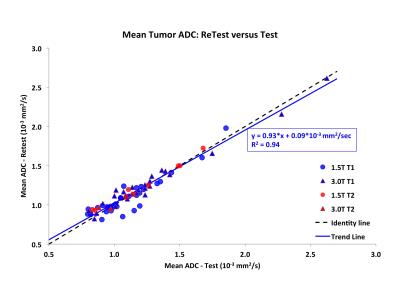 |
Reproducibility of ADC measures by Breast DWI: Results of the ACRIN 6698 Trial 
David Newitt, Zheng Zhang, Jessica Gibbs, Savannah Partridge, Thomas Chenevert, Patrick Bolan, Mark Rosen, Helga Marques, Nola Hylton
The multi-institutional ACRIN 6698 trial investigates quantitative diffusion weighted imaging (DWI) for assessment of breast cancer response to treatment. A secondary aim is to perform a test/retest study to evaluate reproducibility of ADC measures. In a subset of 91 subjects, DWI was acquired twice in the same exam, before and after patient repositioning. Tumor ADC was measured separately for each acquisition. 80% of cases were found analyzable by a standardized quality-control procedure. Reproducibility of ADC was excellent, with intraclass correlation coefficient of 0.97 (95%CI 0.95, 0.98) and agreement index of 0.83 (95%CI 0.76,0.87). Results were similar for subgroups by field strength or study visit.
|
17:51
|
0950.
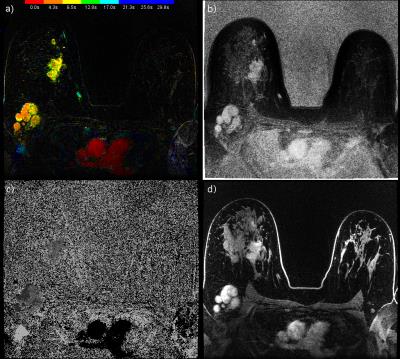 |
Earlier detection of breast cancer by abbreviated MRI screening using color intensity projections (CIP) applied to high spatiotemporal resolution imaging 
Keith S Cover, Katya M Duvivier, Pim de Graaf, Ben J Slotman, Joost PA Kuijer, Mark BM Hofman, Rudolf M Verdaasdonk
Dynamic contrast enhancement (DCE) MRI is more sensitive than X-ray based mammography for detecting breast cancer especially for the 10% of women with extremely dense breasts. However, full diagnostic protocol (FDP) MR exams are too expensive for screening. Recent abbreviated MR protocols - which require only one quarter of the acquisition time - use high spatial temporal resolution (HSTR) sequences that generate thousands of images. We found color intensity projections (CIP) reduces radiologist reading time for detection of malignant tumours by visualizing their amount and time of enhancement (TOE) especially in combination with the value of the maximum slope (VMS).
|
18:03
|
0951.
 |
Validation of contralateral parenchymal enhancement on DCE-MRI as a biomarker of survival in patients with ER-positive/HER2-negative breast cancer - permission withheld
Bas van der Velden, Elizabeth Sutton, Luca Carbonaro, Ruud Pijnappel, Elizabeth Morris, Kenneth Gilhuijs
This study was performed to validate whether MR contrast-enhancement in stromal tissue of the disease-free breast is related to the survival of patients with cancer in the other breast. A recent study in 398 patients with estrogen-receptor positive and human-epidermal-growth-factor-2 negative invasive breast cancer showed that more pronounced contralateral parenchymal enhancement (CPE) was associated with improved patient survival. In this study, we extracted CPE to re-test the finding in a comparable patient population from an independent cancer center. In 287 patients, CPE reproduces as a biomarker for long-term survival. This reproducible imaging finding has potential towards the personalization of care.
|
|










